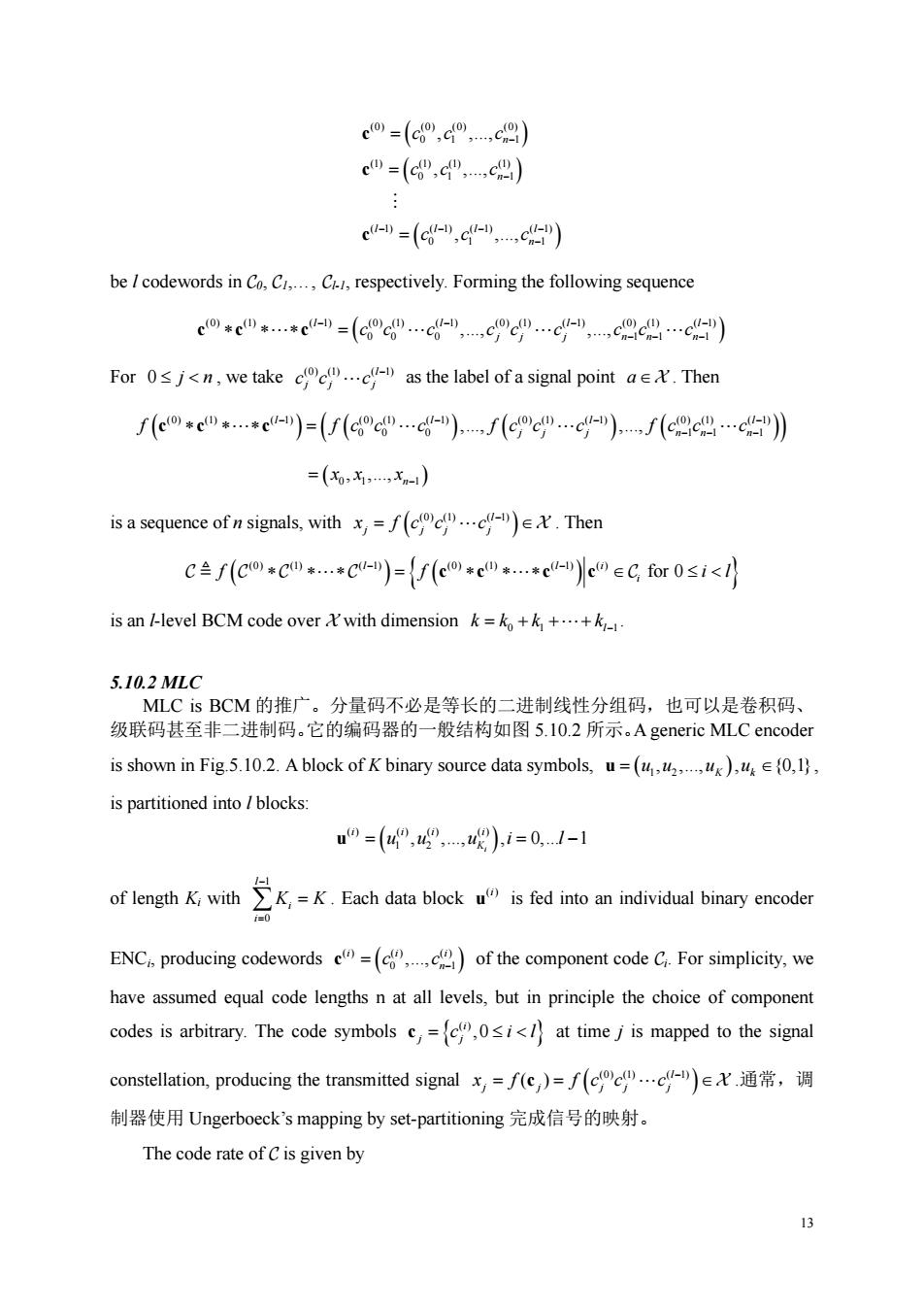正在加载图片...

co=(c0,c0,c9) c"=(c,c",c) c-=(c-,c-,c) be I codewords in Co.CC,respectively.Forming the following sequence co*c四*.*c-=(C0c.c-,c0c".C-,cc.c) For 0j<n,we takeas the label of a signal point a.Then f(co*c四.*c-)=f(cc".c-),f(cc".c-),f(cc.c)》 =(,x-) is a sequence of n signals,with=f(.Then cf(co*Cw**C-)=k*e"*.*e-je0 e for0si< is an /-level BCM code over with dimensionk=k+++ 5.10.2MLG MLC is BCM的推广。分量码不必是等长的二进制线性分组码,也可以是卷积码、 级联码甚至非二进制码.它的编码器的一般结构如图5.l0.2所示。A generic MLC encoder: is shown in Fig.5.10.2.A block of K binary source data symbols,u=()0 is partitioned into /blocks: u0=(49,49,2),i=01-1 of lnghach daa blcd inniry cncoer ENC producing codewords=)of the component code C For simplicity,we have assumed equal code lengths n at all levels,but in principle the choice of component codes is arbitrary.The code symbols c=at time j is mapped to the signal constellation,.producing the transmitted signal,=fc,)=f(cc"c-)eX.通常,调 制器使用Ungerboeck'smapping by set-partitioning完成信号的映射。 The code rate of C is given by 13 ( ) ( ) ( ) (0) (0) (0) (0) 01 1 (1) (1) (1) (1) 01 1 ( 1) ( 1) ( 1) ( 1) 01 1 , ,., , ,., , ,., n n l ll l n cc c cc c cc c − − − −− − − = = = c c c # be l codewords in C0, C1,., Cl-1, respectively. Forming the following sequence ( ) (0) (1) ( 1) (0) (1) ( 1) (0) (1) ( 1) (0) (1) ( 1) 00 0 11 1 ,., ,., lll l jj j nn n cc c cc c cc c −−− − −− − cc c ∗ ∗∗ = " "" " For 0 ≤ <j n , we take (0) (1) ( 1) l jj j cc c " − as the label of a signal point a ∈X . Then ( )( ) ( ) ( )( ) (0) (1) ( 1) (0) (1) ( 1) (0) (1) ( 1) (0) (1) ( 1) 00 0 11 1 ,., ,., ll l l jj j nn n f fcc c fcc c fc c c −− − − −− − cc c ∗ ∗∗ = " "" " ( ) 01 1 , ,., n x x x = − is a sequence of n signals, with ( ) (0) (1) ( 1) l j jj j x fcc c − = ∈ " X . Then ( ) { ( ) } (0) (1) ( 1) (0) (1) ( 1) ( ) for 0 l li i f f il − − C CC C C " " ∗ ∗ ∗ = ∗ ∗ ∗ ∈ ≤< cc c c is an l-level BCM code over X with dimension 01 1 l kk k k = +++ " − . 5.10.2 MLC MLC is BCM 的推广。分量码不必是等长的二进制线性分组码,也可以是卷积码、 级联码甚至非二进制码。它的编码器的一般结构如图 5.10.2 所示。A generic MLC encoder is shown in Fig.5.10.2. A block of K binary source data symbols, u = ∈ (uu u u 1 2 , ,., , {0,1} K k ) , is partitioned into l blocks: ( ) () () () () 1 2 , ,., , 0,. 1 i i ii i K u = =− uu u i l of length Ki with 1 0 l i i K K − = ∑ = . Each data block ( )i u is fed into an individual binary encoder ENCi, producing codewords ( ) () () () 0 1 ,., iii n c c = − c of the component code Ci. For simplicity, we have assumed equal code lengths n at all levels, but in principle the choice of component codes is arbitrary. The code symbols { } ( ) ,0 i j j c = c il ≤ < at time j is mapped to the signal constellation, producing the transmitted signal ( ) (0) (1) ( 1) ( ) l j j jj j x f fcc c − = c = ∈ " X .通常,调 制器使用 Ungerboeck’s mapping by set-partitioning 完成信号的映射。 The code rate of C is given by